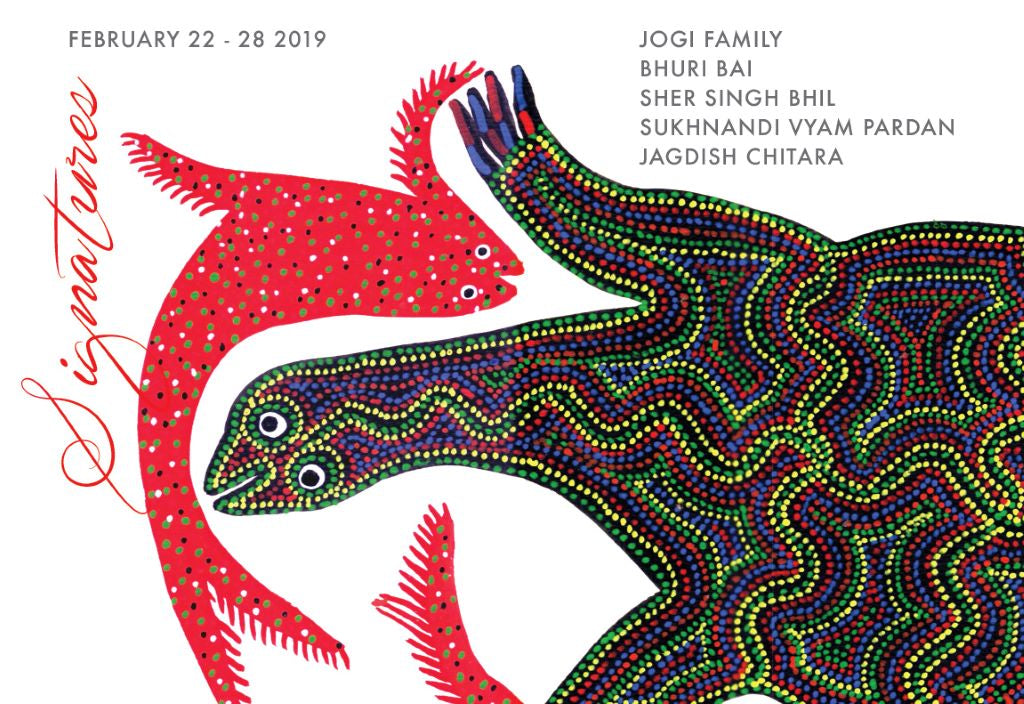JOGI FAMILY, BHURI BAI, SHER SINGH BHIL, SUKHNANDI VYAM PARDHAN, JAGDISH CHITARA | Signatures

SIGNATURES presents the work of five artists that ARTISANS’ launched for the first time in Mumbai between 2012 – 2016. Over the years Radhi Parekh, Director of ARTISANS’, has nurtured their growth, and added to a collection that has not been seen together until now.
Unschooled but educated in the intuitive play of form and color, unlettered but informed of a sophisticated visual vocabulary, these artists represent compelling voices from the heartland of India.
Decrying labels such as ‘tribal’ and ‘folk’ art, critic Ranjit Hoskote says, artists such as these represent a “third field of artistic production in contemporary Indian culture which is neither metropolitan nor rural, neither (post)modernist nor traditional, neither derived from academic training nor inherited without change from tribal custom.”
Sukhnandi Vyam Pardhan
As keepers of their people’s cultural legacy, powerful storytelling is intrinsic to the Pardhan identity. Sukhnandi studied art under his uncle, the legendary Jangarh Singh Shyam. “We think of the plants and trees as our Gods and Goddesses,” the artist says “we believe they all have spirits dwelling within them.” His anthropomorphic figures conjure ideas of the food chain as well as the natural cycle of birth and decay.
The Jogi Family
Ganesh Jogi, a traditional balladeer from Rajasthan, was first prompted to draw with pen-and-ink on paper in 1981 by the artist, Haku Shah. Today each of the family is an artist in their own right. Their intricate drawings are stories of origin, migration, urban settlement, adaptation and survival, with keenly observed detail.
Jagdish Chitara
Today Jagdish Chitara’s Mata-ni-Pachedi is significant, as he practices the original form of painting as an act of worship, directly on cloth without any premeditated drawing. “Only those with a pure mind and heart are able to paint the Mata-ni-Pachedi,“ says Jagdish, who feels connected to his ancestors when painting. Jagdish draws with unusual vitality and has developed a distinct style to animate the stories that surround the Mother Goddess.
Bhuri Bai of Pitol
Bhuri Bai of Pitol is the first Bhil artist to use paper and canvas for her painting. She was discovered by artist J Swaminathan, the first Director of Bharat Bhavan, Bhopal – a turning point for her, from a local painter who painted on mud walls, to a contemporary artist with international recognition. Bhuri Bai is a keen observer of life around her, and she paints with the vivacity and immediacy of someone who is intensely present.
Sher Singh | Bhil painting
Sher Singh Bhil chronicles the Bhil rituals through his paintings. Sher Singh believes that painting is a form of prayer and healing. Closely connected to the earth, he paints observations of the daily life of the Bhil, including animals, trees, mythological heroes, deities, festivals, and with a keen eye for detail. Bhil painting is composed of myriad dots. Of the many stories connected to the use of the dot, Sher Singh believes that each dot is representative of an ancestor.
“Each artist has a distinct signature,” says Radhi. Their foray into art is extraordinary; the story of their lives, a compelling saga of enduring hope, shaped by hardship, poverty, migration, and the will to survive and create in the face of brutal change.

